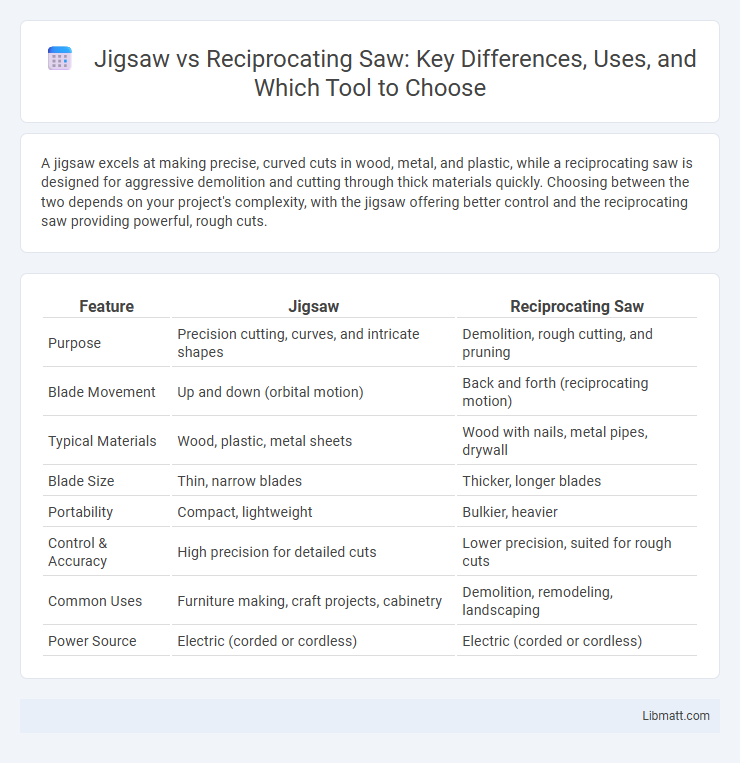A jigsaw excels at making precise, curved cuts in wood, metal, and plastic, while a reciprocating saw is designed for aggressive demolition and cutting through thick materials quickly. Choosing between the two depends on your project's complexity, with the jigsaw offering better control and the reciprocating saw providing powerful, rough cuts.
Table of Comparison
| Feature | Jigsaw | Reciprocating Saw |
|---|---|---|
| Purpose | Precision cutting, curves, and intricate shapes | Demolition, rough cutting, and pruning |
| Blade Movement | Up and down (orbital motion) | Back and forth (reciprocating motion) |
| Typical Materials | Wood, plastic, metal sheets | Wood with nails, metal pipes, drywall |
| Blade Size | Thin, narrow blades | Thicker, longer blades |
| Portability | Compact, lightweight | Bulkier, heavier |
| Control & Accuracy | High precision for detailed cuts | Lower precision, suited for rough cuts |
| Common Uses | Furniture making, craft projects, cabinetry | Demolition, remodeling, landscaping |
| Power Source | Electric (corded or cordless) | Electric (corded or cordless) |
Understanding Jigsaws and Reciprocating Saws
Jigsaws feature a small, straight blade that moves up and down, making them ideal for precise, curved cuts in wood, plastic, and metal. Reciprocating saws use a longer, more aggressive blade designed for demolition and rough cuts, capable of cutting through wood, metal, and even tree branches. Both tools operate on a reciprocating motion but serve different purposes due to their blade design and cutting capabilities.
Key Differences Between Jigsaw and Reciprocating Saw
Jigsaws feature a narrow, vertical blade ideal for intricate, detailed cuts and curved patterns, while reciprocating saws use a longer, horizontal blade designed for aggressive demolition and rough cutting in tight spaces. Jigsaws typically offer variable speed control for precision, whereas reciprocating saws emphasize power and stroke length to handle tougher materials like wood with nails or metal pipes. The portability and blade versatility of reciprocating saws make them suitable for heavy-duty jobs, contrasting with the jigsaw's specialization in fine woodworking and craft applications.
Jigsaw Uses and Ideal Applications
A jigsaw excels in making intricate cuts, curves, and bevels on wood, metal, and plastic, making it ideal for detailed woodworking, crafting, and home renovation projects. Its compact design and variable speed settings allow precise control for cutting stencils, patterns, and cabinetry components. Your ability to maneuver the blade easily around corners makes the jigsaw perfect for versatile and fine-cut applications compared to the aggressive straight cuts of a reciprocating saw.
Reciprocating Saw Uses and Ideal Applications
Reciprocating saws excel in demolition tasks, cutting through materials like wood, metal, and plastic with aggressive back-and-forth blade motion, making them ideal for remodeling and renovation projects. Your ability to quickly cut pipes, nails, and tree branches demonstrates the tool's versatility in rough, outdoor, or construction-site environments. Unlike jigsaws, reciprocating saws prioritize power and speed over precision, suitable for heavy-duty, fast-paced cutting applications.
Blade Types and Compatibility
Jigsaws use narrow, fine-toothed blades designed for intricate curves and plunge cuts, compatible with T-shank or U-shank blade systems that fit securely into the tool's collet. Reciprocating saws employ longer, thicker blades with aggressive teeth optimized for demolition and straight cuts, featuring universal shanks compatible with a wide range of blade types for cutting wood, metal, and plastics. Blade compatibility significantly influences cutting precision and material suitability, making the choice between jigsaw and reciprocating saw blades crucial for project success.
Cutting Performance: Precision vs Power
A jigsaw delivers superior precision for intricate and curved cuts, making it ideal for detailed woodworking and templates. In contrast, a reciprocating saw offers greater power and speed, excelling in demolition tasks and cutting through tougher materials like metal and thick wood. Your choice depends on whether precise control or raw cutting power aligns better with your project requirements.
Safety Considerations for Both Tools
Jigsaw and reciprocating saws require distinct safety precautions to prevent accidents and injuries. Always wear protective gear such as safety goggles, gloves, and hearing protection due to the high-speed blades and vibrations involved. Ensure blades are securely fastened and disconnected from power sources before changing them, while keeping hands clear of cutting paths during operation to maintain optimal safety.
Versatility and Portability Comparison
Jigsaws offer superior versatility with their ability to perform intricate cuts, curves, and bevels on various materials, making them ideal for detailed woodworking and craft projects. Reciprocating saws, though less precise, excel in demolition and heavy-duty tasks due to their robust design and aggressive cutting action, often at the expense of portability because of their larger size and weight. For your projects requiring mobility and fine control, a jigsaw provides lightweight ease and maneuverability, whereas a reciprocating saw suits heavy-duty outdoor or construction work where power outweighs portability.
Price and Maintenance Factors
Jigsaws generally come with a lower price point compared to reciprocating saws, making them more accessible for hobbyists and light-duty tasks. Maintenance costs for jigsaws are typically minimal, often limited to blade replacements and occasional lubrication. Your choice depends on budget constraints and the frequency of use, as reciprocating saws may incur higher expenses due to more robust components and heavier-duty blade replacements.
Choosing the Right Saw for Your Project
When choosing between a jigsaw and a reciprocating saw, consider the project's precision and material type; jigsaws excel in cutting curves and detailed shapes on wood, metal, and plastic, while reciprocating saws are ideal for demolition and rough cuts with their powerful, aggressive strokes. Jigsaws offer better control for intricate tasks such as cabinetry or flooring, whereas reciprocating saws handle tougher materials like pipes or framing lumber efficiently. Evaluating the required accuracy, blade compatibility, and cutting speed ensures selecting the right saw optimizes productivity and results.
Jigsaw vs reciprocating saw Infographic

 libmatt.com
libmatt.com